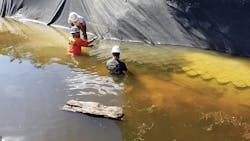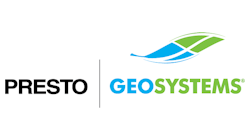Geosynthetic materials have many diverse applications. In addition to stabilizing soil and limiting erosion, they can also be used to manage stormwater quantity and improve water quality, provide irrigation above and below the surface, collect runoff, and more.
Butler County. OH
In the Ohio Department of Transportation’s (ODOT’s) central office, “We do training and create standards for district managers and their employees,” says Jeff Syar, administrator for ODOT’s Office of Hydraulic Engineering. “In our inventory and inspection program, culverts are more prominent because there are so many—80,000-ish—and 14,000 bridges.”
In 2016, ODOT’s list of road repairs included a deteriorating culvert invert beneath State Road (SR) 732. The location was south of the city of Oxford, between Dayton and Cincinnati. ODOT’s standard practice for such repairs is to do field paving, putting down a layer of reinforced concrete that is 3 inches thick. R.B. Jergens Contractors had already signed a contract with ODOT’s District 8 to perform precisely that work on the corrugated metal arch stormwater culvert, which measured 114 inches by 77 inches.
However, engineers in ODOT’s Office of Hydraulic Engineering had been considering using an alternative method of repair. They wanted to try Milliken’s Concrete Cloth GCCM (geosynthetic cementitious composite mat) in a culvert lining/protection demonstration project.
Syar felt that repairs with this product might be as long-lasting as the standard concrete. They could probably be done faster as well. He says ODOT “always welcomes the chance to do pilot projects with new materials to help minimize traffic disruption.”
So, with the same contractor but a different material, the work went ahead. The repair project required approximately 1,000 square feet of Concrete Cloth CC8 fabric to cover the invert in the usual manner. The Concrete Cloth extended the entire length of the culvert, 62 feet.
Work began in May 2016. ODOT workers paid close attention and learned from the contractor how to use Concrete Cloth correctly so that they could do future projects by themselves.
One week later, the culvert invert had its new lining. It extends upward the standard one-third of the height of the culvert's walls.
Syar says that the culvert invert under SR 732 “has held up. They’ve monitored it for more than a year. We were pretty calculating in choosing this culvert for the pilot project.”
Choosing carefully meant selecting a culvert that was not in the worst possible shape. On a scale of 0 to 9, with a rating of 0 indicating the worst state of corrosion, this culvert rated a 5 or 6.
Syar says that the major challenge of the pilot project was “to find a good candidate. We looked all over our districts. Concrete Cloth is not for use on culverts that are in really bad shape.”
Soil structure was also a consideration. Syar notes that a flexible product “gains strength from the backfill [around it]. You can’t just put a liner in, whether it’s concrete paving or Concrete Cloth. The soil at this site was okay and the invert not that far gone. Once perforations occur, they’re an avenue for migration of the backfill.”
The contractor’s cost for using the Concrete Cloth was the same as if they had used the standard field paving. “It was more ease of installation and saving time since we didn’t have to have a concrete mixing truck out there,” says Syar.
Soon after the culvert invert project was finished, the area was hit with a major storm. “It survived a pretty significant amount of rainfall—about four inches,” recalls Syar.
He believes there would be no linear limit to using the Concrete Cloth, as long as the work crew had access for installation. “In the research [at OSU] they used a different orientation. The Concrete Cloth was installed lengthwise. On this project in Butler County, we laid it crosswise, like shingles, so the water flows over it.”
He adds, “It is anchored with metal screws to the culvert while it is uncured. Then it is cured with water. As far as I know, there is no strength added. In field paving, you can add strength by putting in wire mesh or welding rebar across the bottom of a culvert that is in bad shape.”
Syar recommends good weather for using either Concrete Cloth or field paving. “You want a dry day. You can pump out the standing water in the invert, but if it’s raining the culvert would be refilling continually.”
Since this culvert invert project was done, ODOT “has created supplemental specifications for the agency’s districts to use Concrete Cloth in other projects,” says Syar. (The specification, published in July 2018, can be seen on the ODOT website: www.bit.ly/2qnJ7q8.)
He adds that interest in using Concrete Cloth has increased. “Our highway managers have asked that this product be put on a maintenance contract.” Once that is accomplished, in the near future, it will be easier for the ODOT districts to obtain the product. “We’re limited on how much we can spend with any one vendor unless a product is put on a maintenance contract,” explains Syar.
Syar says that Concrete Cloth “is competitive against concrete field paving. Field paving has been the standard since back in the 1980s and requires a bit more labor. Concrete Cloth won’t replace it, but it’s cost-effective and easy to put in, provided the culvert is large enough for the crew to get inside.”
ODOT has also used Concrete Cloth for slope protection. Syar says that on these projects, “It is functioning well. Getting rock under bridges has always been an issue. Maintaining geosynthetics [in these sites] is much easier.”
He says ODOT will probably be using Concrete Cloth more often in the future. Because it hasn’t been used much, not all of the staff in all of the districts are aware of its potential.
Miami Lakes
Storms and hurricanes cause water levels in the stormwater canals of South Florida to rise and fall rapidly. These abrupt water level changes result in the loss of topsoil and erosion of the banks along the canals.
In Miami Lakes, FL, so much topsoil had been eroded that it interfered with the flow of stormwater in the canals. Additionally, the banks, which are adjacent to residential backyards, were becoming unstable.
The city hired ADA Engineering of Doral, FL, and ENCO Engineering Construction of Pembroke Parks, FL, to repair the damage. ADA Engineering specified the use of Presto Geosystem’s Geoweb, a geosynthetic stabilizing and confinement system.
ADA Engineering had also used Geoweb in a similar project on the banks of stormwater canals in Doral. Florida’s sandy soils, hit with the eroding forces of storms, frequently need stabilizing support. Larry Larson, vice president of supplier R.H. Moore & Associates in Tampa, FL, says, “We sell a lot of Geoweb.”
Phase one of the canal bank stabilization project in Miami Lakes began in late fall 2016. It was finished in February 2017, with good working weather and no interference from alligators, though the crew did see one small snake.
“The Geoweb is functioning very well,” says Isabella Micolta, ENCO’s supervising contractor for the job. She says the project’s biggest challenge was that “there was no right of way to work from. The space was so limited that all of the work had to be done from the water, using floating barges about 20 feet by 80 feet long.”
Micolta explains that the Geoweb, 6 inches deep and in sections 30 inches wide, extends from the top of the bank down about 5 or 6 feet. No dewatering was needed. The Geoweb was placed below the waterline but not all the way to the bottom of the canal. The canal averages about 10 to 15 feet deep.
An excavator sitting on a barge filled the Geoweb cells with rocks, which were then graded in by hand. The cells can be filled with various types of soil and plants or inert materials. In this case, no plants or seeds were added.
“We put grass on top, on the bank. It will grow down and cover the Geoweb, which is green [to blend in and look natural]. We used bahia grass because it doesn’t require as much water and there is no irrigation there,” explains Micolta.
She says she is surprised that after the project, “the canal bank looks so much better. It was steep, irregular, and difficult to work on the edge of the canal before. Now it is easy for someone to walk on.”
Aer-Flo’s Tough Guy turbidity curtains were used to keep sediment and debris from entering the canal water.
Alex Vazquez, vice president with ADA Engineering, served as the engineer of record for the Doral canals project. Jeff Vollat, senior engineer and office lead at ADA Engineering, was the engineer of record for the Miami Lakes project.
Vollat says the project’s main challenge was that “the town of Miami Lakes had a set amount of money for construction from NRCS [Natural Resources Conservation Service] grant money, and we could not go over that amount. So we had to get accurate costs on the Presto Geoweb material installation and plan for an endpoint accordingly.”
For Vazquez, the main challenges of the Miami Lakes project were “dealing with the permitting agencies and the homeowners [along the canal]. Some of them thought the right of way was part of their backyard. They had built docks and patios [on the right of way] that the city made them remove.”
Most of the properties have sprinkler systems that draw water for irrigation from the stormwater canals. Some of the Miami Lakes residents were also unhappy that the county made them cut their sprinkler links to the canal water.
Vazquez also notes the lack of working area was a challenge. “Usually it is more cost-effective to work from the land side of the canal, but there were only five or six feet of space from the properties there.”
He adds, “With limited space, you need to go with a [stabilizing] system that is more vertical”—hence the Geoweb with its 6-inch setbacks of cells. “Using a flat slope eats up a lot of space.”
Several years ago, the ADA Engineering team presented the city of Doral with three possible stabilizing options. The first was sandbags, which Vazquez says people don’t like because they crack.
The second option presented was the Geoweb. “It is UV-protected and almost blends in. The city really liked the way it looked, the aesthetics,” notes Vazquez.
The third option considered was vertical sheet piles. It was cost-prohibitive and, unlike the Geoweb, which is like a series of small steps, a person falling into a canal lined with sheet piles can’t get up the slick walls to escape.
City officials in Miami Lakes had the advantage of seeing the canal work with Geoweb already finished in Doral. In Miami Lakes, the work on the one long canal is being done in two phases. The first phase extended for 2,854 linear feet. The second phase will be started in late winter and be finished sometime in the summer of 2019. It will cover 3,354 linear feet. The Geoweb cells are filled with #57 stone.
Vollat is pleased with how the Geoweb has worked in Miami Lakes. “Beyond the aesthetics of the product, which look great, it provides the vertical treatment in a confined canal right-of-way space, which was needed for this specific product.”
He adds, “Installation was not invasive to nearby residents—the contractor performed work mostly via barge in the canal—and overall the residents are very pleased with the final product.”
The Doral stormwater canal stabilization project is much larger. The work is now on the seventh year of a 10-year contract.
“We’re doing about two miles of canals a year in Doral,” says Vazquez.
One small problem, however, has developed in the Miami Lakes project. Vazquez says it is a mystery why in the first vertical cell or two of Geoweb the rocks have been loosened. Perhaps iguanas are to blame, though nobody knows for sure and the problem has not happened in the Doral project. Green iguanas, which can grow up to 3 to 5 feet long, are an invasive species in Florida.
Vollat says, “A lesson learned that we will be implementing going forward is to fill the first two rows of Geoweb cells with flowable fill to provide a solid base that has a minimum chance of washing out. Sometimes iguanas or other critters would burrow into the aggregate, and it caused isolated washouts of structural fill material above it.”
To halt the problem, ENCO has gone back and filled these lower two rows of Geoweb with the cement-like flowable fill substance. The contractor will do this as a preventive measure while phase two is being installed.
The Wave
Building a water park and swimming pool complex in California after several years of drought might seem, at best, unwise. At worst, it might appear to be the antithesis of water conservation.
But if the water park and its swimming facility are carefully designed for saving and reusing water in every possible way, that is a different situation. Then the facility becomes not only feasible but worthy of both LEED certification and community pride.
Such is the happy situation with the Emerald Glen Recreation and Aquatic Center in Dublin, CA. Known informally as “The Wave” and completed in May 2017, the facility is owned by the city of Dublin. It was dreamed of and planned—with numerous revisions—for years and is the final part of the 48-acre city-owned Emerald Glen Park.
The aquatic center is an 11-acre complex. It includes an indoor pool for community recreation, a deep-water competition pool, a water park, a water playground, and an outdoor amphitheater, plus some water-themed amenities and entertainment features.
The final section of Emerald Glen Park was designed by Gregor Markel, senior architect and senior principal at the Dahlin Group. This architecture and planning firm has offices in Pleasanton, San Diego, and several other California cities.
Landscape design was done by Carducci Associates of San-Francisco. Several members of the firm worked on the project, including Bill Fee, principal, and Jamie Beckman, associate principal.
City of Dublin officials wanted the aquatic center’s long natatorium to have a transparent ceiling, but achieving this feature without the usual steel support posts was a challenge. It required using a material other than glass.
Markel and the Dahlin Group team found their solution by using ethylene tetrafluoroethylene (ETFE) for the curving roof. ETFE weighs only a fraction of what glass does, yet it lets in 95% as much light.
At the time the building was finished, it had the first ETFE ceiling in northern California and it was only the second such roof in the entire state.
Features that earned LEED Gold points for the project include those that help to manage stormwater. The parking lot and fire lane are both covered with special weight-bearing pavers that are hidden by the grass growing above them.
“We had used Grasspave2 before, for fire lanes and maintenance lanes, but not on a parking lot. That was the architect’s idea,” says Fee.
Grasspave2 pavers are made by Invisible Structures of Golden, CO. The sections are made from 100% recycled plastic and measure 20 by 20 inches by 1 inch thick.
Besides providing stormwater a way to infiltrate onsite, and thereby preventing possible flooding and reducing sediment loads in runoff, they provide an attractive green alternative to hard asphalt. And because they are cooler, they also reduce the heat island effect.
The independent plastic rings that compose the pavers are connected in an interlocking, flexible geogrid. Installed below the surface, the sections are filled with sand and then planted with grass seed.
Available in rolls of 750 square feet, they can easily be installed by one person. To cover the fire lane and parking lot at the aquatic center, 9,500 square feet of pavers were used.
“The parking lot looks great,” says Fee. “People don’t even know the pavers are underneath.”
Runoff from the roof and impervious surfaces flows into three bioretention basins spread out across this section of the park. The three basins measure approximately 5,000, 10,000, and 20,000 square feet—almost 3/4 of an acre. Native California rushes and other water plants help remove pollutants from the runoff before it goes to the municipal sewer system.
The Carducci team used another geosynthetic product in this project—Eco-Mat from Hunter Industries of San Marcos, CA. This company specializes in subsurface irrigation systems. Its drip irrigation system is used for conveying recycled city water to the grass in the pavers.
“It’s like a wet blanket. You put water into it under the soil and the [plant] roots grow down into it,” explains Fee.
The Carducci Associates team did landscaping design for the last three of the four phases of Emerald Glen Park’s development. “We used a lot of coastal live oaks, a California native,” says Fee.
Other native trees added include Chinese elm, London plane, sycamore, and Callery—also known as Bradford—pear. The park’s site had been undeveloped federal government property for years, which allowed existing trees such as Italian stone pines the time to grow large.
Other native plants predominant in the park include California deer grass, various rushes, and roses (rosa rugosa). The grasses on the lawns and open spaces are cool-season, either fescue or a mixture of ryegrass and bluegrass.
The Emerald Glen Recreation and Aquatic Center complex has won numerous awards. They include the 2018 American Public Works Association Public Works Project Award and the 2017 California Park and Recreation Society Award of Excellence, Facility Design.













